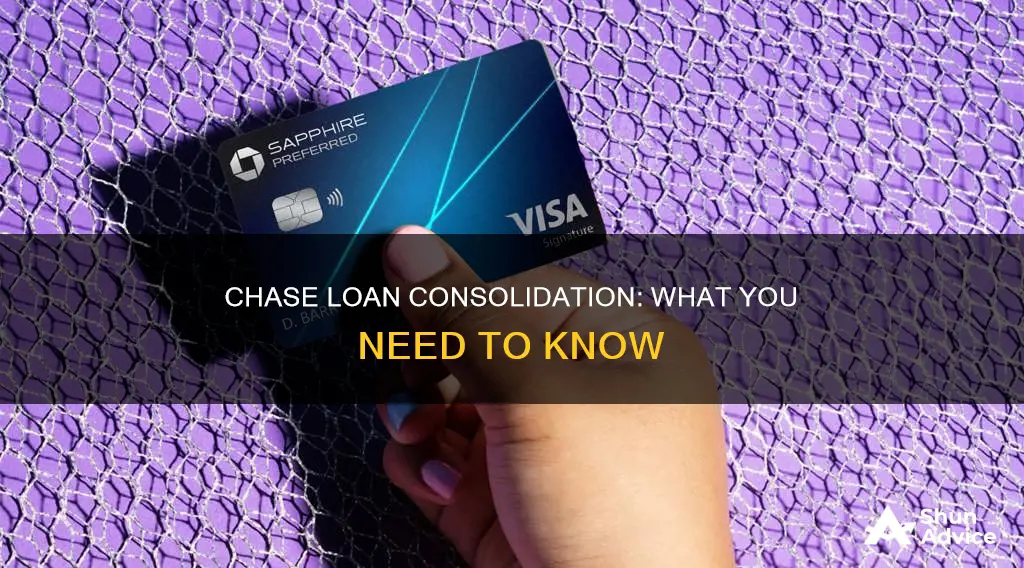
Chase does not offer unsecured debt consolidation loans or personal loans for any purpose. However, it is possible to consolidate debt with Chase through a balance transfer offer or a home equity loan. Chase offers a 21-month 0% interest period on balance transfers, which can be used to move high-interest debt to a lower interest rate account. Homeowners may also use the money from a home equity loan or HELOC to pay off high-interest credit card debt and then pay off the home equity loan at a lower rate.
| Characteristics | Values |
|---|---|
| Does Chase offer debt consolidation loans? | No, Chase does not offer debt consolidation loans or unsecured personal loans. |
| What does Chase offer? | Chase is a full-service bank offering a variety of services including checking and savings accounts, credit cards, auto loans, home purchase and refinance loans, and home equity lines of credit. |
| What are some debt consolidation options? | Home equity loans, HELOCs, balance transfer cards, non-profit credit counseling services, personal loans, and My Chase Loan. |
| What are some pros of debt consolidation? | Simplify your financial life, save you money, improve your credit score, and lower interest rates. |
| What are some cons of debt consolidation? | May not reduce your interest rate, potential fees, and risk of losing your home if you default on a home equity loan. |
What You'll Learn
- Chase does not offer debt consolidation loans, but it's not impossible to consolidate debt with them
- Chase offers a balance transfer offer with a 21-month 0% interest period
- Home equity loans and HELOCs can be used for debt consolidation
- The snowball method: paying off the smallest loans first and then moving on to larger ones
- The avalanche method: paying off the debt with the highest APR first

Chase does not offer debt consolidation loans, but it's not impossible to consolidate debt with them
Chase does not offer debt consolidation loans, but that doesn't mean it's impossible to consolidate debt with them. If you own a home and have equity, you can use a home equity loan or a home equity line of credit (HELOC) to consolidate your debt. A HELOC works like a credit card, allowing you to borrow money whenever you need it, up to a certain limit based on the value of your home minus your mortgage balance. However, since it is secured by your home, you risk losing your home if you can't make the payments.
Chase also offers a balance transfer option, which allows you to move high-interest debt to a lower-interest account. Their current offer includes a 21-month 0% interest period, which can help you save money and simplify your payments. However, balance transfer offers usually come with a low introductory rate that adjusts to a higher rate after the introductory period, so be sure to understand the terms before signing up.
Additionally, Chase offers a flexible, lower-APR loan called My Chase Loan, which allows you to borrow money from your existing card's available credit. This option provides fixed monthly payments with no origination or early payoff fees, and you can continue using your card for purchases.
Before consolidating your debt, it's important to understand your financial situation. Take stock of what you owe, your monthly income, and your credit score. Also, consider the pros and cons of each debt consolidation option to make an informed decision. You can also use the snowball or avalanche methods to help manage your debt.
Schwab Loans: What You Need to Know
You may want to see also

Chase offers a balance transfer offer with a 21-month 0% interest period
Chase offers a balance transfer credit card that can help you consolidate credit card debt. The card comes with a 21-month 0% interest period, meaning you can transfer your existing credit card debt to this card and pay it off within the 21-month period without accruing any additional interest. This can be a useful way to save money and simplify your payments by combining multiple debts into a single monthly payment.
It's important to note that this balance transfer offer is only available if you have good credit standing, and there may be other eligibility requirements to consider. Additionally, Chase does not allow you to transfer balances between Chase credit cards.
The Chase balance transfer card also provides opportunities to earn cash back on purchases. However, after the introductory 21-month period, the interest rate will adjust to a higher variable APR, which can increase your overall debt if not managed carefully.
While Chase does not currently offer unsecured personal loans or debt consolidation loans, they do provide other options for debt consolidation. For example, if you own a home, you can consider a cash-out refinance or home equity line of credit to pay off your credit card debt at a lower interest rate. However, it's crucial to understand the risks associated with using home equity, as falling behind on payments could result in foreclosure.
Additionally, Chase offers the "My Chase Loan" feature, which allows eligible cardmembers to borrow money from their existing card's available credit at a lower fixed APR than their standard purchase APR. This option provides flexible repayment terms and no early payoff fees, giving cardholders a way to consolidate their debt within their existing credit line.
Chapter 7: Wiping Out Loans and Debts
You may want to see also

Home equity loans and HELOCs can be used for debt consolidation
Homeowners can use home equity loans and HELOCs (home equity lines of credit) to consolidate multiple debts into a single loan with a lower interest rate. This can help to simplify payments and lower monthly outgoings. However, it is important to remember that your home is used as collateral for these types of loans, so you risk losing your home if you cannot keep up with repayments.
Home equity loans and HELOCs are similar in that they both allow you to borrow against the value of your home. However, there are some key differences. Home equity loans provide a lump sum at a fixed interest rate, with set principal-plus-interest payments from the start. HELOCs, on the other hand, provide a revolving line of credit that you can borrow from as needed, typically with a period of interest-only payments, followed by interest-plus-principal payments, with variable interest rates.
HELOCs offer more flexibility as you can borrow exactly the amount you need when you need it, rather than taking out a lump sum. They can be a good option if you only need to borrow a small amount temporarily, acting as a bridge until you can access another source of funding or pay off the loan with cash. However, home equity loans can provide more stability as you don't have to worry about future rate changes.
When deciding between a home equity loan and a HELOC, it's important to consider your financial situation and comfort level. Home equity loans may be a good choice if you have a lot of equity in your home and can comfortably make the loan payments on top of your mortgage. They offer lower monthly payments and interest rates, but the payment period is longer, and your home is at risk if you can't pay. With a HELOC, the monthly payments and interest may be higher, but the damage of defaulting is less severe.
Cashfloat and US Loans: What You Need to Know
You may want to see also

The snowball method: paying off the smallest loans first and then moving on to larger ones
Chase Bank offers a variety of financial services, including checking and savings accounts, credit cards, and auto loans. The bank also has a mortgage department that provides home purchase and refinance loans, as well as home equity lines of credit.
While Chase does not currently offer unsecured debt consolidation loans, it does provide several options for consolidating credit card debt. One option is to take advantage of the credit available on a Chase credit card to obtain a flexible, lower-APR loan deposited directly into a bank account. This option has no application fee or new account to manage and offers fixed monthly payments at a lower rate than the standard Purchase APR.
Another option for consolidating credit card debt is to consider a balance transfer offer, which involves moving high-interest debt to a lower-interest rate account. Chase offers an attractive balance transfer deal with a 21-month 0% interest period. However, it's important to note that balance transfer offers typically have a low introductory rate that adjusts higher after the initial period.
Now, let's discuss the snowball method for paying off loans, which is a strategy that focuses on paying off the smallest loans first and then moving on to larger ones. Here's how it works:
- List Your Debts: Make a list of all your debts, excluding your home, and arrange them from the smallest to the largest amounts.
- Minimum Monthly Payments: In the next column, list the minimum monthly payment required for each debt.
- Pay Minimums and Focus on the Smallest Debt: Each month, pay the minimum amount due on each debt. However, for the smallest debt, try to pay more than the minimum by adding a fixed amount, such as $100 or more if you can afford it.
- Roll Payments to the Next Debt: Once the smallest debt is fully paid off, take the total amount you were paying towards it (minimum payment plus the extra) and add that to the minimum payment of the next smallest debt.
- Repeat Until All Debts are Cleared: Continue this process, focusing on one debt at a time and rolling the payments to the next debt in line until you have paid off all your debts.
The snowball method is about building momentum as you pay off your debts. It can be highly motivating to see your smallest debts disappear quickly, giving you a sense of progress and encouraging you to stay on track. However, it's important to note that this method may result in paying more interest over time compared to other debt repayment strategies, such as the avalanche method, which focuses on paying off debts with the highest interest rates first.
Cashland Installment Loans: What You Need to Know
You may want to see also

The avalanche method: paying off the debt with the highest APR first
Chase does not currently offer unsecured debt consolidation loans. However, there are other ways to consolidate your debt. One option is to take advantage of the credit you already have on your Chase credit card by using My Chase Loan to get a flexible, lower-APR loan. This loan uses a portion of your card's available credit and is deposited directly into your bank account. There are no origination or early payoff fees, and you can continue to use your card for purchases.
If you are considering consolidating your debt, it is important to understand the different methods available to you. One such method is the avalanche method, which involves paying off the debt with the highest annual percentage rate (APR) first. This strategy is ideal for those who are analytical and patient as it requires making minimum payments on all debt accounts and using any extra funds to pay off the debt with the highest interest rate.
The avalanche method can help you save on accrued interest over time, but it may take a while to knock out the first debt. It requires discipline to regularly put your extra cash into paying off a particular debt, not just the minimum. This strategy also assumes that you have a constant amount of discretionary income that you can apply to your debts. If your daily living expenses increase or emergency expenses arise, you may have to stop using this method.
To use the avalanche method, start by listing all your debts and their respective interest rates, from highest to lowest. Next, make a budget to determine how much more than the minimum you can put toward your debt each month. Put that extra amount toward your account with the highest interest rate each month until you wipe out that debt. Once the highest-interest debt is paid off, you tackle the next-highest interest rate, and so on. With this method, you can save money and time by reducing the time it takes to pay off your debt.
CashnetUSA: Understanding Their Installment Loan Options and More
You may want to see also
Frequently asked questions
Chase does not offer unsecured debt consolidation loans or personal loans for any purpose. However, you can use a balance transfer offer as a debt consolidation solution. Chase offers a 21-month 0% interest period, but you cannot transfer balances from one Chase card to another.
The best way to consolidate debt is to take out a new loan or credit card with a lower APR than your current debts and then use it to pay them off. This will turn multiple monthly payments into one, and the lower APR will reduce the total amount you owe.
The snowball method is a debt consolidation strategy that involves paying off your smallest loans first and as quickly as possible. Once the smallest debt is paid off, you tackle the next-smallest, and so on.
The avalanche method is a debt consolidation strategy that involves paying off the debt with the highest APR first. Once the highest-interest debt is paid off, you tackle the debt with the next-highest interest rate, and so on.
HELOC stands for Home Equity Line of Credit. It allows you to borrow money up to a certain amount based on the value of your home minus your mortgage balance. A HELOC is secured by your home, so you could lose your home if you can't pay back the money. However, HELOCs offer extremely low-interest rates, which can be beneficial for debt consolidation.







